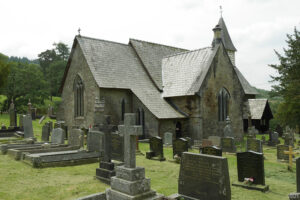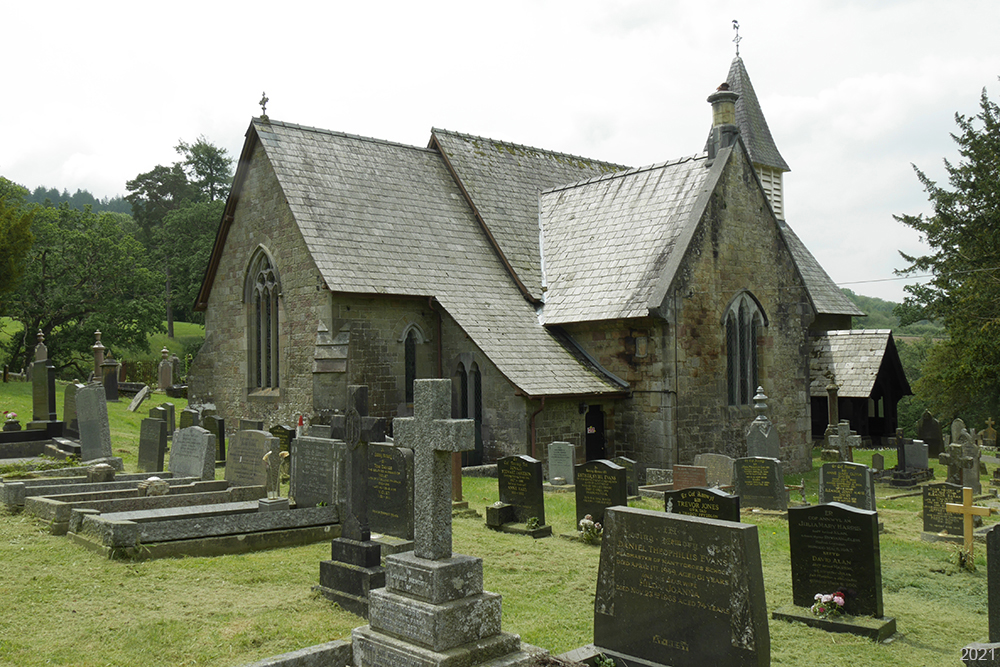
ST MICHAEL,
LLANFIHANGEL ABERBYTHYCH,
CARMARTHENSHIRE (DINEFWR)
Dyfed PRN 4726
RB No. 3678
NGR SN 5898 1972
Not listed (1998)
Listed Building No. 22179
Listed Grade II*
First Listed in 1999. Last amended in 1999.
SUMMARY
19th century church; 0% pre-19th century core fabric. On site of, and in same location as, pre-19th century church.
A multicell church, small-medium sized. Consists of chancel, 2 bays; nave, 3 bays; north transept, 1 bay; north porch; vestry (north), 1 bay; all c.1850. Construction is in squared and coursed ORS rubble. Openings all from c.1850 and neogothic, in ORS and grey oolite; limited external buttressing, c.1850; western timber bellcote/turret, c.1850. Slate gable roofs; vestry with a slate lean-to roof; bellcote with a low slate ‘spire’.
Roofs, floors and finishes: c.1850.
Condition – good.
Archaeological potential – good. Below-ground oil-tank and cutting against 5% of church; shallow earth cutting around 50% of church; suspended floors above a void in 75% of church; some external memorials significantly close to 100% of church.
Structural value (pre 19th century) – poor. 0% pre-c.1850 core fabric.
Group value – medium. C19, good-quality landmark church; hillslope location on edge of estate and park, with estate village buildings; circular churchyard; lych-gate.
Phasing:
All c.1850.
DESCRIPTION
St Michael, Llanfihangel Aberbythych, is a multicelled church, of small-medium size. It was entirely (re)built in c.1850, on the same site, and in the same location as its predecessor, but retaining nothing from the earlier fabric.
The present church consists of a 2-bayed chancel, a 3-bayed nave, a north transept, a single-bayed vestry between the chancel and transept, and a north porch. Construction is in squared and coursed Old Red Sandstone rubble; the interior is plastered. Openings are neo-gothic, from c.1850, and include ‘Early English’ lancets and windows with simple tracery; dressings are in sandstone and grey oolite. The east and west ends are buttressed externally, c.1850. The north porch is half-timbered. The nave west bay carries a square, timber bellcote/turret, louvered throughout and with a fish-scale slated ‘spire’, supported on internal timbers from the nave floor, all c.1850. The north transept gable carries a disused chimney, c.1850. The roofs are slated gables; the vestry has a slated lean-to roof.
Nothing remains from the pre-19th century church. The earlier church was described in 1833 as a ‘small neat edifice, (which) was, according to the tablet recording the event, erected in 1617 (and) repaired in 1753’ (Lewis, 1833). The tithe map of 1839 (NLW, Llanfihangel Aberbythych, Tithe Map, 1839) depicts a small, possibly single, cell with a north transept, in the same location as the present church. The church was remarkable for the region in possessing a timber bellcote/turret, rising from the floor of the nave west bay and emerging through the roof, of which the present bellcote is a faithful copy (Jones, 1864, 263). In 1672 the church wanted ‘a new bell for the steeple’ (Evans, 1921, 64).
The church was entirely rebuilt in c.1850 to the designs of the architect (Sir) George Gilbert Scott (Anon., 1855, 303).
A boiler was installed in the vestry, with a below-ground oil-tank between the vestry and the chancel north wall, in the later 20th century. There have been no major subsequent alterations.
The font is modern.
The oil tank is below-ground and occupies a cutting north of the chancel. A shallow earth cutting runs along the east and north walls. Floors are suspended above a void in the nave, transept and vestry. Some external memorials lie significantly close to the church.
The church was not listed in 1998.
Now Listed Grade II*
First Listed in 1999. Last amended in 1999.
It is possible that an unidentified early church stood on the Tywi floodplain to the north of the present church (Sambrook and Page, 1995 (ii), 75); local tradition has it that this was the original site of the parish church before the 1617 rebuild, but this cannot be confirmed, while the present churchyard is circular.
SITE HISTORY
There is some evidence for the pre-conquest religious use of the site –
Circular churchyard; pre-conquest Latin dedication.
St Michael, Llanfihangel Aberbythych, was a parish church during the post-conquest period (Rees, 1932) of the medieval Deanery of Stradtowy. The rectory was in the gift of Talley Abbey, valued at £6 13s 4d in 1536 (Owen, 1894, 324).
After the dissolution, the church eventually fell into private patronage. In 1833 the living, a perpetual curacy in the patronage of the Earl of Cawdor, was endowed with £200 private benefaction, £400 royal bounty and £800 parliamentary grant (Lewis, 1833).
In 1998 St Michael, Llanfihangel Aberbythych, was a parish church. The living was a vicarage, held with Llangathen and Llanfihangel Cilfargen (Benefice no. 800) in the Archdeaconry of Carmarthen, Rural Deanery of Llangadog and Llandeilo (St Davids, 1997-8).
SOURCES CONSULTED
Written Evidence
NLW, Ordnance Survey 1:2500, First Edition, Sheet XLI.6.
NLW, Ordnance Survey 1:2500, Second Edition, Sheet XLI.6.
NLW, Parish of Llanfihangel Aberbythych, Tithe Map, 1839.
Rees, W., 1932, South Wales and the Border in the XIVth century.
Church in Wales Records
St Davids, 1997-8, Diocesan Year Book.
NLW, SD/F/324, Faculty – Stained glass window, 1927.
Parish Records, Carmarthenshire Record Office, Carmarthen
(CPR/20 – Llanfihangel Aberbythych)
Unpublished Accounts
Sambrook, R. P., and Page, N. A., 1995 (i), The Historic Settlements of Dinefwr (Unpublished client report; copy held with Dyfed SMR).
Sambrook, R. P., and Page, N. A., 1995 (ii), The Historic Settlements of Dinefwr: Gazetteer (Unpublished client report; copy held with Dyfed SMR).
Printed Accounts
Anon., 1855, ‘Llandeilo Meeting’, Archaeol. Cambrensis, Vol. IV, Third Series.
Anon., 1919, ‘Miscellanea’, Archaeol. Cambrensis, Vol. XIX, Sixth Series.
Crossley, F. H., and Ridgway, M. H., 1947, ‘Screens, Lofts and Stalls situated in Wales and Monmouthshire: Part 8’, Archaeol. Cambrensis, Vol. XCIX.
Evans, G. E., 1915, ‘Churchwardens’ Presentments, AD 1684’, Transactions of the Carmarthenshire Antiquarian Society Vol. 10.
Evans, G. E., 1917, ‘Churchwardens’ Presentments, AD 1705’, Transactions of the Carmarthenshire Antiquarian Society Vol. 11.
Evans, G. E., 1921, ‘Church Items, 1739-1820’, Transactions of the Carmarthenshire Antiquarian Society Vol. 14.
Jones, H. L., 1864, ‘Wooden Belfries in Wales’, Archaeol. Cambrensis, Vol. X, Third Series.
Jones, M. H., 1919, ‘The Ecclesiastical Place-Names of Carmarthenshire’, Archaeol. Cambrensis, Vol. XV, Sixth Series.
Lewis, S., 1833, A Topographical Dictionary of Wales.
Owen, E., 1894, ‘The History of the Premonstratensian Abbey of Talley, Part 2’, Archaeol. Cambrensis Vol. XI, Fifth Series.
Price, D. L., 1879, ‘Talley Abbey, Carmarthenshire’, Archaeol. Cambrensis Vol. X, Fourth Series.
RCAHM, 1917, Inventory: Carmarthenshire.
Salter, M., 1994, The Old Parish Churches of South West Wales.
Updated: August 2021 – PKR


